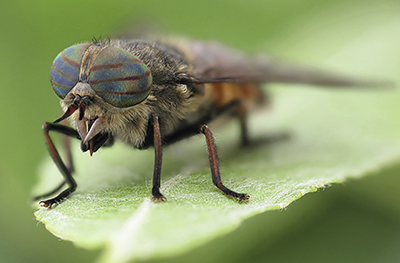Skin Problems? Protect your horse from summertime ectoparasites
Whilst the lovely sunshine of the last few weeks has brought many of our horses a welcome break from winter rugs, summer is also the season where most skin complaints are brought to light. Sarah Hogg BA VetMB MRCVS from Paragon Equine in Cumbria explains more ...
 Whether you have an itchy, bumpy, scurfy or fly-bothered horse, here are some of the most common skin parasites we see in the UK and how you can start to recognise, treat and prevent them.
Whether you have an itchy, bumpy, scurfy or fly-bothered horse, here are some of the most common skin parasites we see in the UK and how you can start to recognise, treat and prevent them.
Lice
Although lice don’t tend to be much of a problem during the summer, they are definitely something to keep an eye out for as the weather turns cooler again. Thick coats and horses standing closer together when grazing, do give lice the ideal opportunity to spread. When horses have lice, they tend to rub against things and bite at themselves. The coats of affected horses have a dry, patchy appearance and are often scurfy – as if they’re suffering from dandruff. Tiny white ‘nits’ (lice eggs) may be seen stuck to the coat and are often easiest to spot under the forelock.
Some lice are ‘chewing’ species, which feed on dead skin and debris, whilst others are ‘biting’ and feed directly on the horses’ blood.
Although there are plenty of products available at the tack shop to treat lice, veterinary grade pour-on solutions are generally more effective (for example Deosect). No treatment will kill the eggs, so the prescribed pour-on treatment should be repeated after 10 - 14 days once existing eggs have hatched.
Lice are easily spread between horses via grooming kit and rugs, so each horse should have their own. Rugs should be washed at a temperature above 50 degrees and if lice keep recurring, your vet can advise you on treating the horse’s environment and equipment with Deosect or a similarly effective solution.
Mites
Also known as ‘feather mites’ or ‘heel mange’, Chorioptes mites are much smaller than lice and invisible to the naked eye. Affected horses are incredibly itchy and can get very distressed as they try to scratch, rub or bite the backs of their fetlocks and pasterns, often injuring themselves or their skin further on fences or stable doors as they try and seek relief. It is most commonly seen in feathered breeds, such as cobs.
Vets will sometimes diagnose mites through a skin scrape because the mites are visible with a microscope as they sit on the hair or burrow into the skin, but most of the time the symptoms seen on a clinical examination are enough to confirm the presence of mites.
There is no licensed treatment for equine Chorioptic mange in the UK at the moment. Injections of a cattle product Dectomax (doramectin) under the skin are effective and most vets agree are very safe. The injection isn’t effective against mites in the hair or environment though, so clipping feathers is helpful where possible. A topical wash is also available to kill mites on the hair coat. As it takes two weeks for eggs to develop into adults, any treatment should be repeated after a fortnight. The stable should be emptied and steam cleaned to try and reduce mites in the environment, although it is notoriously difficult – if not impossible - to eradicate them completely.
Flies and midges
The most problematic type of midge in the UK is known as Culicoides and is the species which most commonly causes sweet itch (also known as insect bite hypersensitivity or IBH). Those horses which react to midge saliva – a condition which has a hereditary element – become incredibly itchy when bitten and this can cause them great distress. The mane and tail are usually the worst areas affected by midge bites. Midges tend to rest amongst herbage in the day and are most active at dawn and dusk. They particularly dislike hot, dry weather and bright sunshine so these are ideal days for turnout – and this is why in many areas, midges have been less of a nuisance this summer.
There are two types of flies which cause problems for horses in the UK:-
‘Biting flies’ pierce the horse’s skin to feed on blood. This can spread disease directly, for example the bovine papilloma virus which causes sarcoids, or cause an allergic reaction.
‘Non-biting flies’ breed easily, spread disease and cause irritation to horses, which can prevent them from grazing normally. Horseflies (a female horsefly is pictured left) are a biting species most numerous in the warm summer months in woodland and grassland areas and are recognisable by their large size (7 – 10mm). As well as biting horses on the neck, legs, withers and stomach, they will also bite humans – most of us are familiar with the large, itchy lumps these bites invariably cause.
Horseflies (a female horsefly is pictured left) are a biting species most numerous in the warm summer months in woodland and grassland areas and are recognisable by their large size (7 – 10mm). As well as biting horses on the neck, legs, withers and stomach, they will also bite humans – most of us are familiar with the large, itchy lumps these bites invariably cause.
Smaller ‘black flies’ (2 – 5mm) prefer to bite around the horse’s face and ears, which can be very uncomfortable, as well as the neck and under the stomach. It’s worth noting that although sweet itch is usually caused by midges, occasionally it can be due to a type of black fly called Simulium equinum.
Fly and midge control
The secret to fly and midge control is starting before your horse is reacting to painful bites. Where possible, choose grazing on high, breezy, well drained ground away from woods and ponds. A good quality, well-fitted fly rug provides a physical barrier to bites and treatment with an equine-specific product containing permethrin should repel and kill any flies and midges that do bite. DEET is effective, but can act as an irritant to some horses. Avon’s ‘Skin So Soft’ spray is a gentler alternative that might help repel some species and bringing horses in at dusk and dawn where midges are most active may also prevent bites.
Ticks
Although many owners are still unaware of the risks ticks posed to horses in the UK, climate change is increasing the risk of tick-borne disease as their habitats extend and life cycles shorten.
There are several species of ticks in the UK, but the most common one is called Ioxides ricinus. These ticks prefer shade and dense plant growth on the ground, and are more prevalent in areas with plenty of sheep and deer. In Southern England, ticks are active year-round, while in the North there is often a quiet period over winter. As winters get warmer and wetter, tick activity is being noted in all but the coldest months. Ticks are blind, so wait on undergrowth or grass tips. When they sense ammonia (in breath or sweat), warmth or movement, they quickly latch on to a host.
Lyme Disease is the most common tick-borne disease in the UK. Ticks transmit a spirochaete bacteria called Borrelia burgdorferi into the horse’s bloodstream causing dullness and depression, fever, shifting lamenesses, eye problems and – occasionally – neurological issues. It is usually diagnosed with two blood samples taken two weeks apart to show a rising response to the bacteria. It’s thought that most cases of Lyme Disease go undiagnosed, but where it is picked up, it is treated with specialist antibiotics. There is currently no fully licensed treatment for equine Lyme Disease in the UK.
As well as the potential for serious disease, ticks also cause skin irritation which can result in infection.
The key to preventing tick disease is remaining vigilant and regularly checking your horse to make sure he or she doesn’t have any ticks attached. Ticks that bite your horse will also latch onto people or dogs who brush past, so get into the habit of regularly checking any exposed skin or medicating dogs to prevent bites. If you do find a tick, don’t crush or twist them – this causes the tick to regurgitate which increases the chance of infection or disease. Topical substances such as alcohol, baby oil or Vaseline should also be avoided as they are ineffective and may cause further irritation to your horse. Instead, wear gloves and gently use a tick remover (or tweezers if you feel confident) to gently remove the tick by the head, where it enters the skin. Once released, kill the tick and apply a gentle antiseptic to the bite site.
If further treatment or a repellent is required, speak to your vet.
Skin condition boosters
Even if your horse doesn’t suffer with a specific skin problem, there are plenty of ways to boost skin health and keep their coats in the best possible condition.
Nutrition plays an important part in skin health. Fatty acids help to keep the skin moisturised and the coat shiny. A plant-based supplement (for example flax oil) can really help some horses. Ensuring an adequate supply and balance of vitamins and minerals is also essential. Copper, zinc, selenium, iron, vitamins A, D, E, K and biotin (vitamin B) are particularly important to skin health. A good quality balancer added to the diet will usually cover all of these and your vet or nutritionist will be able to help you choose the best option for your horse.
On bath days, selenium-based shampoos can be helpful in treating dry or scurfy coats, whilst gentler oatmeal shampoos often help to soothe and relieve itchy horses.

The Equine veterinary team from Paragon Equine in Cumbria
Kelly Smith (left), Sian Edwards (2nd left), Equine Technicians/Nurses, Vet Sarah Hogg (2nd right) and Vet Paul May (right).
Tel: 01768 483789
Email: This email address is being protected from spambots. You need JavaScript enabled to view it.
Website: Paragon Equine Veterinary, Cumbria



